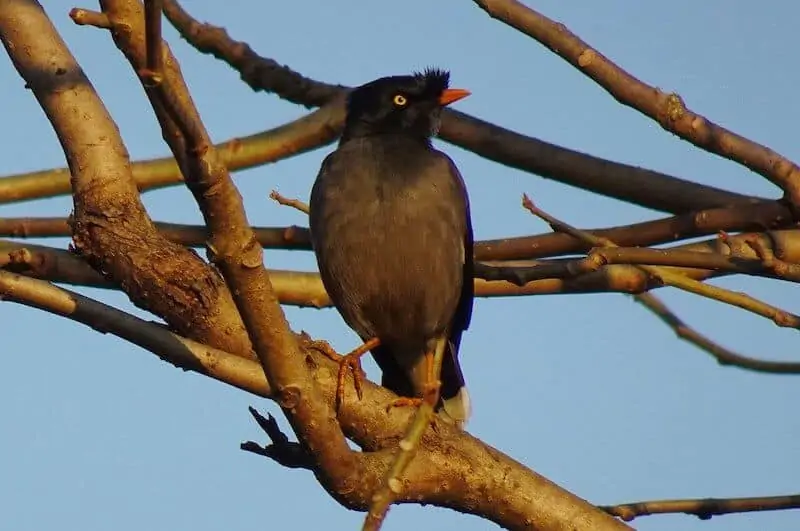This list includes birds from all over the globe that begin with J. Several of the birds are native to Japan, Indonesia, and Asia, while others are indigenous to South and North America. The exquisite colors, attitude, habitat, and feeding habits of these birds were selected.
BIRDS THAT START WITH J
The names of the following 16 interesting and diverse bird species begin with J. Let’s take a look at it.
1. JACKY WINTER

Scientific name: Microeca fascinans
Lives in: Australia, Papua New Guinea
These birds will sing their “peter-peter” tune from early in the morning till lunchtime. Little grey-brown flycatchers are called jacky winter. The three subspecies, which are progressively darker in the south and lighter in the north, have slight color differences. Insectivores, such as the Jacky winter, eat primarily insects throughout the winter. It’s a sit-and-search hunter that flies out from its spot to capture insects and then returns to the same spot.
Fun fact about Jacky winters: They are also known as “stumpbird” and “postboy” because of their habit of perching on stumps and fence posts.
2. JACOBIN CUCKOO
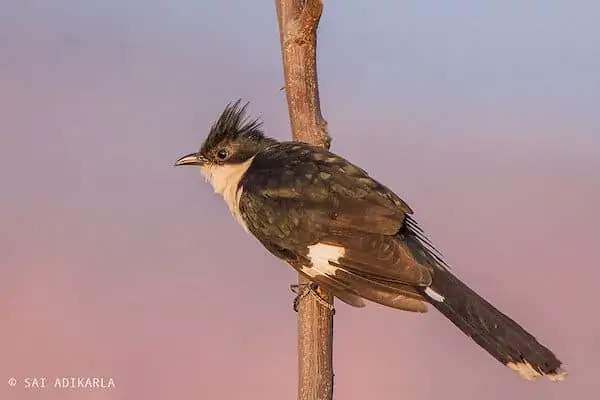
Scientific name: Clamator jacobinus
Lives in: Africa, Asia, India
The Jacobin cuckoo relies on others to raise its offspring, which is a brood parasite. Perching over the edge of another bird’s nest, they laid their eggs quickly. This is typically accompanied by the destruction of one or more of the hosts’ eggs. The host nest normally only produces two hatchlings, despite the fact that several eggs are deposited there. The cuckoo chicks will be raised by the host bird.
Fun fact about Jacobin cuckoos: Because of the timing of their arrival, right before the monsoon season, these birds are considered harbingers of the monsoon rains.
3. JAVA SPARROW
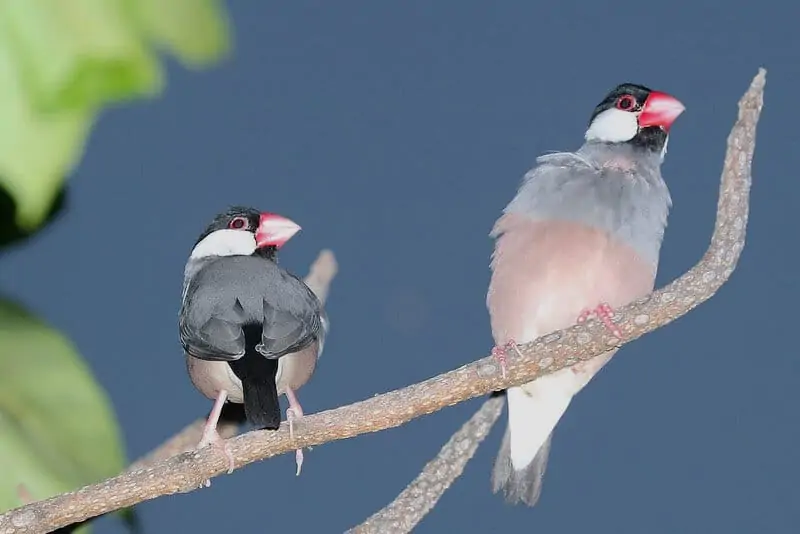
Scientific name: Padda oryzivora
Lives in: Bali, Indonesia, Hawaii
With its thick pink beak, this member of the finch family is unmistakable. The body is gray, and the belly is brownish-pink. The legs are pink, and the head is black with a white cheek patch and a crimson rimmed eye. The social sparrows Java sparrows forage and roost in groups. They consume seeds and grains, which they crush with their hefty beak, and these are the main sources of nutrition. In certain countries, they are viewed as a rice crop pest because of their rice consumption.
Fun fact about Java sparrows: While they are not native to Hawaii, they have thrived since their introduction and can now be found on all of the Hawaiian islands.
4. JAMAICAN ORIOLE
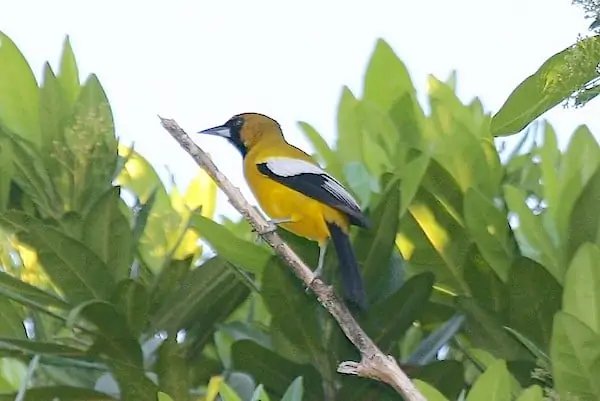
Scientific name: Icterus leucopteryx
Lives in: Jamaica, San Andrés, Nicaragua
The orange oriole and the Baltimore oriole are two species of orioles found on the North American mainland. Yellow with black and white wings, a black face mask, and black beaks, these beautiful birds are easy to spot. From gardens to forests, they have subtropical and tropical habitats. They will continue to search for fruit, which is a significant part of their diet, alongside nectar and insects.
Fun fact about Jamaican orioles: They’ve been dubbed the “Banana Katie” because of their fondness for bananas.
5. JAMBU FRUIT DOVE

Scientific name: Ptilinopus jambu
Lives in: Thailand, Malaysia, Brunei, Kalimantan, Sumatra, Java.
The little brightly colored fruit dove known as the Jambu fruit dove lives in lowland rain forests and mangrove swamps. The black chin and crimson complexion of males may be distinguished. Females, on the other hand, have a purple face that is lighter than their chin. Fruit on the ground or directly on the tree will be eaten by these doves.
Fun fact about Jambu fruit doves: The male will coo while raising its wings and bobbing its body to stake its territory during the breeding season. The guy may deliver a quick peck to fend off other males if the display fails.
6. JAMES’S FLAMINGO

Scientific name: Phoenicoparrus jamesi
Lives in: Peru, Chile, Bolivia, northwest Argentina
Other flamingo species look a lot like James’ flamingos. Their paler pink color and large yellow patch on their beak make them easiest to identify. The flight feathers are a little patch of black at the backend that you may notice. Gray or white hatchlings are the most common. They’ll achieve their pink color by the age of two or three due to their carotene-rich diet.
Fun fact about James’s Flamingo: The knee is not visible, but rather the ankle, which is a large joint in their leg.
7. JANDAYA PARAKEET

Scientific name: Aratinga jandaya
Lives in: northeastern Brazil
The plumage of jandaya parakeets is stunning. It has a green body and wings, reddish-orange back, and blue tips on the wing and tail feathers. Its bill is black, with yellow head, orange cheeks, and a green body. Palm trees and lowland deciduous woodland are their natural habitats. Mangos, palm nuts, and cashew apples are some of the foods it eats.
Fun fact about Jandaya parakeet: Caffeine, chocolate, and some of the chemicals found in avocados are all harmful to this bird species.
8. JAPANESE PARADISE FLYCATCHER

Scientific name: Terpsiphone atrocaudata
Lives in: Japan, South Korea, Taiwan, Philippines
The black head, light breast, brown back, and blue eye-ring of these fascinating birds are all fascinating. Males during breeding can darken considerably, with a purple sheen. Evergreen broadleaf woods in Japan and shady mature deciduous woods are the natural habitat and breeding grounds for Japanese paradise flycatchers. Due to the loss of breeding habitat, breeding numbers have plummeted dramatically.
Fun fact about Japanese paradise flycatchers: The species’ adult breeding males have long streamers of their tails that stream out behind them.
9. JABIRU

Scientific name: Jabiru mycteria
Lives in: South America
The Jabiru is a member of the stork family, so you can Guess Its Shape. They have a crimson pouch at the base of their neck and a mostly white body with a long black neck and head. Males are up to 25% bigger than females, making the Jabiru the highest flying bird in South America. These birds are frequently seen in large flocks near rivers and ponds.
Fun fact about Jabirus: Its English equivalent is “swollen neck,” and it is named after the Tupi–Guaraní language, a South American language.
10. JAPANESE WHITE-EYE

Scientific name: Zosterops japonicus
Lives in: Japan, Korea, Taiwan, China, Philippines, Hawaii, Thailand, Vietnam
The Japanese white-eye, also known as the warbling white-eye and the mountain white-eye, is a bird with many names. The most obvious identifying feature is their large white eye-ring, which is olive-yellow in color with a buffy belly. The majority of these birds’ day is spent in the trees, usually in groups. Fruits, grubs, and nectar make up their menu.
Fun fact about Japanese white-eyes: In 1929, these birds were brought to Oahu. It is one of Hawaii’s most populous land birds, with a population that has quickly grown. They can now be found on all of Hawaii’s islands.
11. JAPANESE WAXWING

Scientific name: Bombycilla japonica
Lives in: eastern Russia, northeast China, Japan, Korea
Waxwings are thin and streamlined, looking like a pair of butterflies. With a black mask, gray wings, and a red under the tail, their plumage is mostly tawny-brown in color. The row of waxy tips on the wings of these waxwings is missing, which distinguishes them from other waxwing species. Fruits and berries are the majority of their diets, but they also consume insects during the summer.
Fun fact about Japanese waxwings: The call of these birds is a high-pitched trill, rather than a true song.
12. JAVAN FROGMOUTH

Scientific name: Batrachostomus javensis
Lives in: Southeast Asia, Indonesia, Philippines
Frogmouths have wide beaks and a squat head with little neck, giving them the appearance of a frog. They are mottled brown and gray in color, which helps them blend in with their surroundings. This nocturnal and crepuscular insect eater feeds on moths, butterflies, beetles, earwigs, and cockroaches at night and in the afternoon.
Fun fact about Javan frogmouths: Downy feathers, bark pieces, and moss are used to construct their nests, which are generally placed on the lowest limb branches of a tree.
13. JUNIPER TITMOUSE
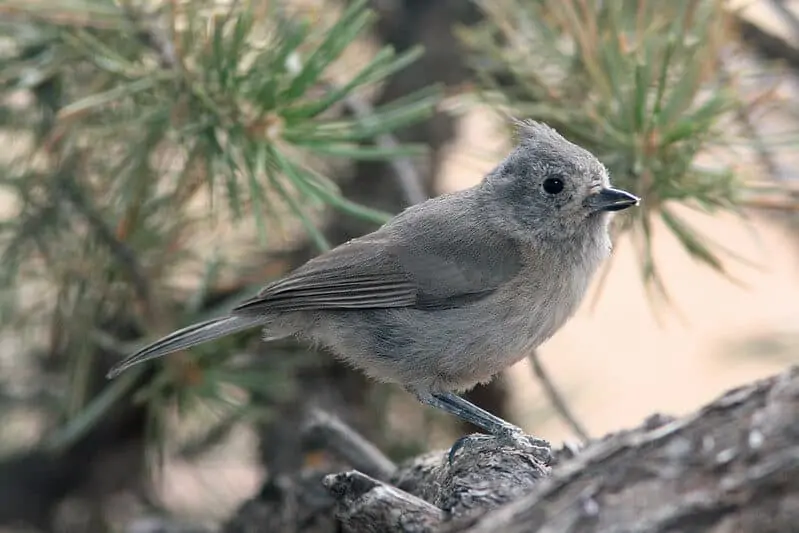
Scientific name: Baeolophus ridgwayi
Lives in: United States, mainly Nevada, Utah, Colorado, Arizona and New Mexico
Titmice may be identified from other birds by their little crest (mohawk). The little gray crest of the juniper titmouse is no exception. With a black eye and a short, slightly thick black beak, juniper titmice are a uniform silver-gray all over. They may not be particularly attractive, but they like to gossip and can be heard in the pinyon-juniper woodlands they call home.
Fun fact about the Juniper titmouse: To get through the winter months, when insects are difficult to find, these titmice will store away a substantial store of seeds.
14. JAVAN GREEN-MAGPIE

Scientific name: Cissa thalassina
Lives in: Indonesian Island of Java
The critically endangered Javan green-magpie has been designated. There are roughly 50 individuals in the last known population count. Others claim that they have become extinct already. It belongs to the Corvidae family, which includes crows. With a crimson red beak, legs, and a circle around its eyes, it has a bright green plumage. The color of juvenile birds becomes bluer as they age, and they become greener. If they are not fed a suitable diet, adult birds in captivity may turn dull blue.
Fun fact about the Javan Green-Magpie: The pigment lutein, which comes from their insect diet, gives them their vibrant green plumage. Little lizards and frogs are also occasionally devoured by them.
15. JAVAN KINGFISHER

Scientific name: Halcyon cyanoventris
Lives in: Indonesian Island of Java, Bali
The bill of the Javan kingfisher is red, and its legs and tail are likewise crimson. They are very territorial and are known to stay extremely close to their nesting area. These birds are solitary by nature, as well. Marshes, mangroves, paddy fields, fish ponds, municipal parks and gardens, orchards, and pastures are all home to javan kingfishers.
Fun fact about Javan kingfishers: These creatures, like their name implies, prefer land and riverbank prey over fish and other strictly aquatic species.
16. JUNGLE MYNA

Scientific name: Acridotheres fuscus
Lives in: Nepal, Bangladesh, India
The starling family includes jungle mynas. The tuff of feathers that stand up at the base of the beak is a fine identifying feather. With gray plumage, darker gray wings, an orange beak, and yellow eyes, they measure approximately nine inches long. Based on plumage, the male and female seem to be the same, and they cannot be distinguished. They are opportunistic feeders that will eat mostly insects, fruit, and seeds foraged on the ground.
Fun fact about Jungle mynas: They’ll sit on the backs of water buffalo and other huge animals, removing the parasites from their hair and eating them in some areas.
